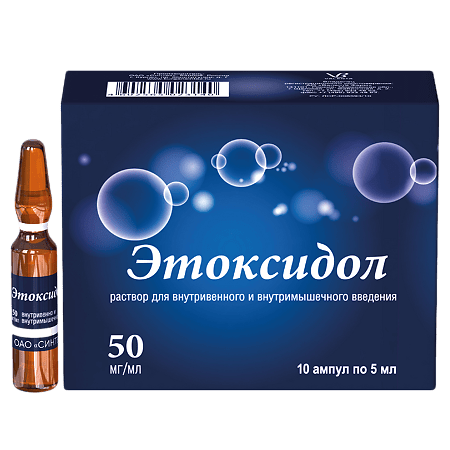No products in the cart.
Etoxidol, 50 mg/ml 5 ml 10 pcs
€53.52 €44.60
Description
It is an inhibitor of free radical processes, has membranoprotective, antihypoxic, nootropic, anticonvulsant, anxiolytic effect, increases resistance to stress. It has anti-ischemic properties, improves blood flow in the area of ischemia, limits the area of ischemic damage, has hypolipidemic effect, reduces the content of total cholesterol and low density lipoproteins.
It increases resistance of the body to various damaging factors, to oxygen-dependent pathological states (shock, hypoxia and ischemia, cerebral circulatory disorders, intoxication with alcohol and antipsychotic drugs (neuroleptics).
The effectiveness in encephalopathies is due to the penetration of ethoxidol through the blood-brain barrier. It improves cerebral metabolism and blood supply of the brain, improves microcirculation and rheological properties of blood, reduces platelet aggregation.
Inhibits lipid peroxidation, increases superoxide dismutase activity, reduces total organic peroxides, increases lipid-protein ratio, reduces membrane viscosity, increases its fluidity. It blocks oxidation of low density lipoproteins.
Modulates the activity of membrane-bound enzymes (calcium independent phosphodiesterase, adenylate cyclase, acetylcholinesterase), receptor complexes (benzodiazepine, GABA, acetylcholine), which helps to maintain the structural and functional organization of biomembranes, transport of neurotransmitters and improves synaptic transmission.
When administered in m/m, it is determined in plasma for 4 hours after administration. TCmax – 0.25 h. T1/2 – 1.15-1.75 h. It is excreted by the kidneys, mainly in glucuron-conjugated form and in small amounts unchanged.
Indications
Indications
Acute cerebrovascular accidents,
dyscirculatory encephalopathy,
autonomic dystonia syndrome,
mild cognitive disorders of atherosclerotic origin,
anxiety disorders in neurotic and neurosis-like conditions,
relief of withdrawal syndrome in alcoholism with a predominance of neurosis-like and vegetative-vascular disorders,
acute intoxication with antipsychotic drugs.
Pharmacological effect
Pharmacological effect
It is an inhibitor of free radical processes, has membrane protective, antihypoxic, nootropic, anticonvulsant, anxiolytic effects, and increases the body’s resistance to stress. It has anti-ischemic properties, improves blood flow in the ischemic zone, limits the area of ischemic damage, exhibits a hypolipidemic effect, reduces the content of total cholesterol and low-density lipoproteins.
Increases the body’s resistance to the effects of various damaging factors, to oxygen-dependent pathological conditions (shock, hypoxia and ischemia, cerebrovascular accidents, intoxication with alcohol and antipsychotics (neuroleptics)).
Efficacy in encephalopathies is due to the penetration of ethoxidol through the blood-cephalic barrier. Improves cerebral metabolism and blood supply to the brain, improves microcirculation and rheological properties of blood, reduces platelet aggregation.
Inhibits lipid peroxidation, increases the activity of superoxide dismutase, reduces the content of total organic peroxides, increases the lipid-protein ratio, reduces membrane viscosity, and increases its fluidity. Blocks the oxidation of low density lipoproteins.
Modulates the activity of membrane-bound enzymes (calcium independent phosphodiesterase, adenylate cyclase, acetylcholinesterase), receptor complexes (benzodiazepine, GABA, acetylcholine), which helps preserve the structural and functional organization of biomembranes, transport of neurotransmitters and improves synaptic transmission.
With intramuscular administration, it is determined in the blood plasma for 4 hours after administration. TCmax – 0.25 hours T1/2 – 1.15-1.75 hours. Excreted by the kidneys, mainly in glucuron-conjugated form and in small quantities unchanged.
Special instructions
Special instructions
During the treatment period, care must be taken when driving vehicles and engaging in other potentially hazardous activities that require increased concentration and speed of psychomotor reactions.
Active ingredient
Active ingredient
Ethylmethylhydroxypyridine malate
Composition
Composition
1 ml of solution for intravenous and intramuscular administration contains:
active ingredient:
ethylmethylhydroxypyridine malate (ethoxidol) 50 mg.
excipients:
N-acetyl-L-glutamic acid 34 mg,
deanol (2-(dimethylamino)ethanol) 16 mg,
glycine 0.1 mg,
disodium edetate (disodium salt of ethylenediamine-N,N,N’,N’-tetraacetic acid 2-water [trilon B]) 0.5 mg,
water for injection up to 1.0 ml
Pregnancy
Pregnancy
Ethoxidol is contraindicated during pregnancy and lactation, since strictly controlled clinical studies of the safety of the drug during pregnancy and lactation have not been conducted.
Contraindications
Contraindications
Hypersensitivity, acute liver and/or kidney failure, pregnancy, lactation, age under 18 years.
With caution: History of allergic diseases and reactions.
Side Effects
Side Effects
Dryness, “metallic” taste in the mouth, sensations of “spreading warmth” throughout the body, sore throat and discomfort in the chest, a feeling of lack of air (usually associated with an excessively high rate of administration and are short-term), with long-term use – nausea, flatulence, sleep disturbances (drowsiness or difficulty falling asleep).
Interaction
Interaction
Enhances the effect of benzodiazepine anxiolytics, anticonvulsants (carbamazepine), antiparkinsonian drugs (levodopa).
Overdose
Overdose
Due to the low toxicity of the drug, an overdose is unlikely. In case of accidental overdose, symptoms of sleep disturbance may occur – drowsiness, insomnia.
Treatment is symptomatic.
Storage conditions
Storage conditions
In a place protected from light at a temperature not exceeding 25 ° C.
Shelf life
Shelf life
3 years
Manufacturer
Manufacturer
Sintez, Russia
Additional information
| Shelf life | 3 years |
|---|---|
| Conditions of storage | In the light-protected place at a temperature not exceeding 25 ° C. |
| Manufacturer | Sintez OAO, Russia |
| Medication form | solution |
| Brand | Sintez OAO |
Other forms…
Related products
Buy Etoxidol, 50 mg/ml 5 ml 10 pcs with delivery to USA, UK, Europe and over 120 other countries.















